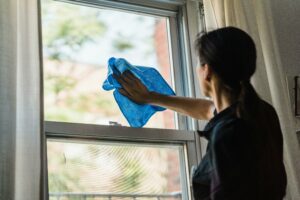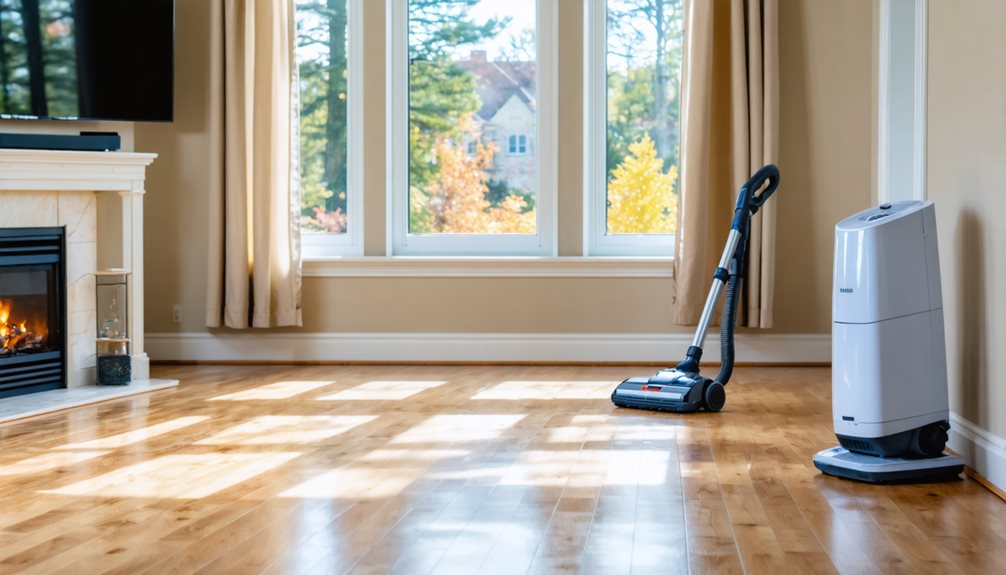Professional cleaning services provide significant relief for Northern Virginia allergy sufferers through advanced allergen removal techniques. HEPA filtration systems capture 99.97% of airborne particles, while steam cleaning technology neutralizes over 90% of dust mites and allergens embedded in surfaces. The region’s unique environmental factors, including high humidity and seasonal pollen, require systematic year-round management protocols. Studies show that professional deep cleaning reduces indoor allergen concentrations by more than 90%, leading to improved respiratory health and decreased asthma symptoms. Comprehensive cleaning strategies address multiple allergen sources, from pet dander to mold spores, creating healthier indoor environments. Further exploration reveals additional benefits of professional intervention versus DIY methods.
Key Takeaways
- Professional cleaning services remove 90% of allergens through HEPA filtration and steam cleaning, providing significant relief for Northern Virginia allergy sufferers.
- Systematic deep cleaning effectively targets regional allergens like dust mites, pet dander, and pollen that are prevalent in Northern Virginia.
- Professional cleaners combat mold growth caused by Northern Virginia’s warm, humid conditions through specialized equipment and techniques.
- Regular professional cleaning maintains allergen-free environments year-round, addressing seasonal variations in pollen and other airborne irritants.
- Advanced cleaning protocols provide superior results compared to DIY methods, with noticeable improvement in air quality within 2-3 days.
Understanding Indoor Allergen Threats
Indoor allergens pose a significant health threat to millions of Americans, with microscopic particles infiltrating living spaces and potentially triggering severe respiratory reactions. Research indicates that over 70 million Americans suffer from indoor allergies, making the management of household allergens a critical health concern.
These microscopic threats primarily manifest through dust mites, pet dander, mold spores, and pollen that settle within homes. Particularly concerning are dust mite droppings, which accumulate in bedding, carpeting, and upholstered furniture, becoming primary triggers for asthma and allergy symptoms. The severity of these reactions is amplified by the fact that particles smaller than 7 microns can penetrate deep into the respiratory system.
Indoor air quality is significantly compromised when these allergens collect in furniture, fabrics, and ventilation systems. The process of removing allergens requires professional intervention, as these particles become deeply embedded in household surfaces over time. Scientific evidence demonstrates that systematic professional cleaning procedures effectively reduce allergen concentrations, creating a healthier indoor environment and providing substantial relief for individuals suffering from allergic sensitivities.
Common Allergens in Northern Virginia
Northern Virginia residents face distinct challenges from region-specific allergens that compound the broader indoor air quality concerns. The area’s unique combination of environmental factors creates an ecosystem where multiple allergen types can proliferate, affecting respiratory health and overall well-being.
Among the most prevalent indoor allergens, dust mites represent a significant concern, particularly in household textiles such as bedding, carpeting, and upholstered furniture. These microscopic organisms thrive in the region’s climate conditions, creating persistent exposure risks for sensitive individuals. Likewise, pet dander poses a substantial threat to indoor air quality, with proteins from dogs and cats being particularly problematic in residential environments.
The region’s characteristic weather patterns contribute to increased outdoor allergen levels, primarily from tree, grass, and weed pollen, which can infiltrate indoor spaces. Additionally, the warm, humid conditions typical of Northern Virginia create ideal conditions for mold growth, further compromising indoor air quality. This combination of allergens affects millions of residents annually, with seasonal variations intensifying exposure risks and symptoms. Understanding these specific allergen threats is essential for implementing effective mitigation strategies.
Professional Deep Cleaning Methods
Professional deep cleaning methods employ advanced HEPA filtration systems that capture microscopic particles as small as 0.3 microns, effectively removing airborne allergens from indoor environments. Steam cleaning technology penetrates deep into carpets and upholstery fibers, utilizing high-temperature vapor to neutralize dust mites and their allergenic byproducts. These cleaning approaches integrate into a multi-stage allergen removal process that can reduce overall allergen concentrations by more than 90%, providing significant relief for allergy sufferers.
Advanced HEPA Filtration Systems
Modern HEPA filtration systems represent a cornerstone of effective allergen removal in professional deep cleaning services. These advanced HEPA filtration systems demonstrate remarkable efficiency by capturing 99.97% of particles as small as 0.3 microns, effectively eliminating common indoor allergens that trigger respiratory distress. The technology’s precise filtration mechanism prevents the re-circulation of microscopic particles, ensuring sustained improvement in indoor air quality.
Clinical studies have shown that professional cleaning services utilizing HEPA filtration provide substantial benefits for allergy sufferers, with allergen reduction effects lasting up to six months post-treatment. The systems’ comprehensive approach to particle capture significantly outperforms standard vacuum cleaners, particularly in treating:
- Deep-seated allergens in carpet fibers
- Microscopic contaminants embedded in upholstery
- Airborne particles settling on hard surfaces
The implementation of these filtration systems in professional cleaning protocols delivers measurable results in reducing allergen concentrations. When combined with systematic deep cleaning methods, HEPA filtration creates a clinical-grade cleaning environment that demonstrably improves indoor air quality and provides meaningful relief for individuals suffering from environmental allergies.
Steam Cleaning Technology Benefits
Through advanced thermal technology, steam cleaning represents a breakthrough in professional allergen management, delivering superior particle elimination and surface sanitization. This methodology penetrates deep into carpets, upholstery, and mattresses, effectively eliminating over 90% of dust mites and allergens through high-temperature vapor application.
The scientific efficacy of steam cleaning lies in its ability to denature protein allergens, fundamentally altering their molecular structure. This transformation renders allergens unrecognizable to the immune system, providing sustained relief for individuals with respiratory sensitivities. The process simultaneously achieves comprehensive surface disinfection, neutralizing harmful bacteria and pathogens that can trigger allergic responses.
Clinical studies demonstrate that steam cleaning significantly improves indoor air quality by extracting deeply embedded allergens from household surfaces. The results become apparent within 48-72 hours post-treatment, with protective benefits extending up to six months. This extended efficacy makes steam cleaning a cornerstone of professional allergen management protocols, offering a scientifically validated solution for maintaining allergen-free environments. For best results, periodic steam cleaning treatments should be integrated into comprehensive indoor air quality management strategies.
Multi-Stage Allergen Removal
Comprehensive multi-stage allergen removal protocols represent the cornerstone of advanced cleaning methodologies designed specifically for allergy management. Professional cleaning services help establish a systematic approach to allergen elimination through scientifically validated processes that target microscopic irritants. The implementation of HEPA filtration systems capable of capturing particles smaller than 7 microns guarantees thorough extraction of allergenic materials from various surfaces.
The multi-stage process systematically remove these allergens through:
- Initial HEPA vacuum filtration to extract loose particulate matter and surface-level contaminants
- Application of specialized protein-denaturing agents that chemically alter allergenic proteins, rendering them immunologically inert
- Deep extraction processes utilizing advanced equipment to remove embedded allergens from carpets, upholstery, and mattresses
This comprehensive approach delivers quantifiable results within 48-72 hours post-treatment, with demonstrated efficacy lasting up to six months. The sustained reduction in allergen levels proves particularly beneficial for individuals with respiratory sensitivities. Regular implementation of these professional protocols maintains consistent environmental control, significantly reducing the risk of allergic reactions and respiratory complications in susceptible individuals.
Year-Round Allergy Management Solutions
For allergy sufferers in Northern Virginia, maintaining consistent allergen control requires a systematic approach to year-round cleaning management. Professional cleaning services implement strategically timed interventions that align with seasonal allergy patterns, guaranteeing continuous protection against environmental triggers.
The implementation of biannual deep cleaning protocols serves as the foundation for effective year-round allergen management. These comprehensive treatments eliminate over 90% of common allergens, including dust mites and pet dander, through the application of specialized cleaning methodologies. Professional services utilize HEPA-filter equipped systems that extract microscopic particles regular cleaning methods often miss.
During peak allergy seasons, intensified cleaning schedules can be particularly beneficial. Professional cleaners adjust their approaches based on specific seasonal challenges, such as heightened pollen counts in spring or increased indoor allergen accumulation during winter months when windows remain closed. The deployment of tailored solutions addresses unique allergen profiles present in different seasons, incorporating targeted treatments for mold prevention and dust mite control. This systematic approach to year-round cleaning maintenance guarantees consistent indoor air quality and provides sustained relief for individuals affected by both seasonal and perennial allergies.

Home Environment Health Impact
Professional cleaning services establish comprehensive indoor allergen defense systems through targeted removal of dust mites, pollen, and pet dander that accumulate in residential spaces. The systematic elimination of these allergens results in measurable advancements to indoor air quality, with potential reductions exceeding 90% of harmful particulates. Clinical studies demonstrate that improved air quality through professional cleaning protocols correlates directly with decreased respiratory symptoms and improved overall health outcomes for allergy-sensitive residents.
Indoor Allergen Defense Systems
Indoor air quality plays a pivotal role in the health and well-being of allergy sufferers, with over 70 million Americans experiencing adverse reactions to common household allergens. Professional cleaners implement comprehensive defense systems to combat these indoor contaminants, achieving up to 90% reduction in allergen populations through systematic deep cleaning protocols.
Effective indoor allergen defense systems incorporate multiple strategies to maintain clean air and minimize exposure to common triggers such as dust mites, pet dander, and mold. These systems typically include:
- Regular deep cleaning of carpets and upholstery utilizing high-efficiency particulate air (HEPA) filtration systems
- Implementation of moisture control measures to prevent mold growth and dust mite proliferation
- Systematic treatment of bedding and fabric surfaces using specialized cleaning agents designed to neutralize allergens
The efficacy of these defense systems depends on consistent application and professional expertise. When properly implemented, these measures significantly reduce the accumulation of harmful allergens in the home environment. This systematic approach to allergen control creates a measurable improvement in indoor air quality, leading to decreased allergy symptoms and improved respiratory health for sensitive individuals.
Air Quality Health Benefits
Scientific research demonstrates that improved air quality through professional cleaning services generates substantial health benefits for residential spaces, extending far beyond basic sanitation. Clinical studies indicate that systematic deep cleaning procedures can reduce airborne allergen concentrations by more than 90%, creating a significantly healthier indoor environment for residents.
Professional cleaning helps target primary allergen sources, particularly dust mites inhabiting bedding and upholstered furniture, which are established triggers for respiratory distress. The thorough elimination of these microscopic organisms, along with pet dander and mold spores, directly correlates with decreased symptom severity in allergy sufferers. This reduction in allergenic particles has demonstrated measurable improvements in respiratory health outcomes.
The implementation of professional cleaning protocols shows particular efficacy in minimizing asthma attack frequency and reducing vulnerability to respiratory infections. For Northern Virginia residents with pre-existing respiratory conditions, maintaining ideal air quality through expert cleaning interventions provides quantifiable benefits. Clinical observations confirm that sustained professional cleaning programs result in improved overall well-being, reduced allergy symptoms, and enhanced quality of life for affected individuals.
Professional Versus DIY Cleaning
The key differences between professional cleaning services and do-it-yourself methods become evident when examining their effectiveness in allergen removal. Professional cleaning services employ specialized equipment like HEPA filter vacuums that capture microscopic particles, achieving allergen reduction rates exceeding 90%. This level of effectiveness significantly surpasses typical DIY cleaning methods, which primarily address surface-level contamination.
The superiority of professional cleaning services is demonstrated through:
- Advanced technological capabilities that penetrate deep into upholstery and mattresses, accessing allergen repositories commonly missed by standard cleaning tools
- Consistent and systematic approach that maintains reduced allergen levels through regular service intervals
- Rapid results manifestation, with visible improvements in air quality and symptom relief within 2-3 days
Scientific evidence supports the improved efficacy of professional cleaning in maintaining ideal indoor air quality. While DIY methods may temporarily improve surface cleanliness, they frequently fall short in addressing the comprehensive spectrum of allergen sources. Professional services provide systematic, thorough cleaning protocols that effectively denature protein compounds from dust mites and pet dander, creating a sustainably healthier living environment for allergy sufferers.
Seasonal Cleaning Considerations
Seasonal transitions in Northern Virginia present unique challenges for maintaining allergen-free environments, particularly during spring and fall when outdoor pollutants infiltrate indoor spaces. During these critical periods, the concentration of allergens such as pollen, mold spores, and dust mites significantly increases, necessitating strategic professional cleaning interventions to maintain ideal indoor air quality.
The implementation of seasonal deep cleaning protocols becomes essential for effectively managing allergen accumulation. Professional cleaning during these transitional periods targets multiple contamination zones, including carpeting, upholstery, and ventilation systems, where allergens typically concentrate. The thorough removal of these particles through specialized cleaning methods helps prevent the compounding effect of seasonal allergen buildup.
Establishing a consistent seasonal cleaning schedule aligns with natural environmental changes and allergen patterns specific to Northern Virginia. Strategic timing of professional cleaning services, particularly before peak allergy seasons, can significantly reduce indoor allergen levels. This proactive approach to seasonal maintenance creates a sustained defense against both existing indoor allergens and the influx of outdoor contaminants, providing long-term respiratory relief for allergy sufferers.
Pet Dander Control Strategies
Managing pet dander requires a comprehensive approach integrating regular pet grooming, optimized air filtration systems, and targeted cleaning of high-accumulation zones. Professional-grade HEPA filtration systems, installed strategically throughout living spaces, work in conjunction with routine pet brushing and bathing to intercept airborne allergens before they settle. Critical areas such as carpets, upholstered furniture, and pet resting spots demand particular attention through systematic deep cleaning protocols to effectively reduce dander concentrations and maintain allergen-controlled environments.
Regular Pet Grooming Essentials
For households with pets, regular grooming serves as a foundation of effective allergen control, particularly in managing pet dander levels throughout living spaces. Weekly grooming sessions significantly reduce the volume of loose fur and skin particles that would otherwise settle into carpets and furniture. When combined with professional home cleaning services, this proactive approach can achieve a remarkable 90% reduction in allergy symptoms.
The implementation of systematic grooming practices, coupled with the expertise of a cleaning company, creates a comprehensive strategy for maintaining ideal indoor air quality. Hypoallergenic shampoos improve these efforts by minimizing dander production at the source, while simultaneously promoting healthier skin and coat conditions for pets.
Key components of an effective pet grooming routine include:
- Weekly brushing sessions to capture loose fur before it disperses
- Regular bathing with specialized hypoallergenic products
- Consistent grooming schedule coordination with professional cleaning services
This scientific approach to pet care not only benefits allergy sufferers but also guarantees the overall well-being of pets through maintained coat health and reduced skin irritation. The systematic removal of pet dander through grooming represents a vital element in comprehensive allergen management.
Air Filtration Best Practices
Effective air filtration systems represent the cornerstone of comprehensive pet dander control in residential environments. The implementation of HEPA filtration technology in both portable air purifiers and HVAC systems proves instrumental in capturing microscopic dander particles measuring as small as 0.3 microns, significantly improving indoor air quality for allergy-sensitive occupants.
To maximize air filtration efficiency, a multi-faceted approach is essential. This includes strategic placement of HEPA-equipped air purifiers in high-traffic pet areas and regular maintenance of HVAC filtration components. The establishment of allergen-free zones, particularly in bedrooms, complements these filtration efforts by creating designated spaces with minimal dander exposure.
Maintaining a clean home through systematic cleaning protocols further improves air filtration effectiveness. This encompasses weekly hot-water washing of pet bedding and regular vacuum maintenance of upholstered surfaces where dander accumulates. The integration of these practices with proper air filtration systems creates a comprehensive strategy for managing pet dander concentrations. When implemented consistently, these measures can substantially reduce allergen levels, providing relief for individuals sensitive to pet dander while maintaining a healthier indoor environment.
Deep Cleaning Problem Areas
Professional deep cleaning protocols targeting pet dander hotspots constitute a critical component of comprehensive allergen management in residential spaces. Through systematic carpet cleaning and upholstery treatment utilizing HEPA-filtered equipment, technicians can effectively extract microscopic allergen particles that trigger respiratory responses in sensitive individuals. The implementation of biannual deep cleaning schedules, combined with regular maintenance, demonstrates measurable reductions in indoor allergen concentrations.
To reduce allergies associated with pet dander, professional cleaning services focus on these critical areas:
- Primary living spaces with heavy pet traffic, requiring specialized carpet cleaning techniques to extract deeply embedded dander particles smaller than 10 microns
- Soft surfaces including upholstered furniture and draperies, which harbor significant quantities of pet-related proteins from skin cells and saliva
- Pet-specific zones such as sleeping areas and play spaces, necessitating thorough sanitization of bedding and textile accessories
Professional intervention in these high-accumulation zones produces quantifiable improvements in indoor air quality within days of treatment. The systematic removal of pet dander through deep cleaning protocols represents an evidence-based approach to allergen reduction, particularly beneficial for households maintaining regular pet residence.
Advanced Allergen Removal Technologies
Modern allergen removal technologies have transformed the way cleaning services combat indoor allergens and respiratory irritants. Professional cleaning services now employ sophisticated HEPA-filter vacuum systems that effectively capture and eliminate microscopic particles as small as 0.3 microns, achieving a remarkable 90% reduction in indoor allergen levels.
These advanced technologies incorporate specialized protein denaturing treatments that specifically target common allergens, including dust mite excrement, pet dander, and mold spores. By altering the protein structures of these allergens, the treatments render them immunologically inactive, preventing the triggering of allergic responses in sensitive individuals.
The technological advancement in cleaning methodologies extends beyond surface-level treatments. Professional cleaning services utilize comprehensive approaches that address both visible and concealed allergen accumulations. These solutions penetrate deep into carpeting, upholstery, and hard-to-access areas, ensuring thorough allergen elimination throughout the residence. The effectiveness of these advanced treatments is typically observable within 2-3 days post-application, providing rapid relief for allergy sufferers while simultaneously improving overall indoor air quality through systematic allergen reduction protocols.
Long-Term Health Benefits
Research demonstrates that consistent, high-quality cleaning interventions yield substantial long-term health improvements for allergy sufferers. Professional cleaning services systematically target and eliminate allergens, bacteria, and pathogens that compromise respiratory wellness. Studies indicate that regular professional cleaning can reduce indoor allergen concentrations by over 90%, creating a measurably healthier living environment.
The long-term health benefits of professional cleaning extend beyond immediate symptom relief. Clinical observations reveal that sustained cleaning protocols contribute to improved lung function and decreased frequency of respiratory infections. In addition, professional cleaning tips emphasize the importance of managing environmental factors such as mold growth, which can significantly impact respiratory health outcomes.
Key benefits of sustained professional cleaning include:
- Reduced risk of asthma exacerbations through systematic allergen control and removal
- Improved indoor air quality leading to enhanced respiratory function and reduced inflammation
- Decreased exposure to harmful pathogens, resulting in fewer respiratory infections and complications
This evidence-based approach to maintaining indoor environmental quality through professional cleaning services demonstrates measurable improvements in both physical and psychological well-being for allergy sufferers.
Frequently Asked Questions
Can Cleaning Help Allergies?
Professional cleaning demonstrably reduces allergen concentrations in indoor environments by over 90%. Clinical studies indicate that systematic cleaning protocols, particularly those utilizing HEPA filtration systems, effectively remove microscopic irritants including dust mites, pet dander, and airborne particles. The implementation of regular cleaning regimens significantly diminishes allergen accumulation, leading to measurable improvements in air quality and corresponding reductions in allergy symptoms within 48-72 hours post-treatment.
What Is the Key When Cleaning for Allergens?
While some may assume basic cleaning is sufficient, effectively targeting allergens requires a strategic approach. The key is focusing on high-accumulation areas where allergens concentrate, specifically carpets, upholstery, and bedding. These surfaces act as reservoirs for dust mites, pet dander, and pollen. Implementation of HEPA filtration systems, capable of capturing particles as small as 0.3 microns, combined with protein-denaturing treatments, guarantees peak allergen removal and neutralization.
How Do You Clean Without Triggering Allergies?
To clean without triggering allergies, implement a systematic approach using specific equipment and methods. Utilize a vacuum cleaner with HEPA filtration to effectively capture allergens rather than dispersing them. Employ damp cleaning techniques instead of dry dusting to minimize particle distribution. Don protective gear, including masks and gloves, to reduce allergen exposure. Maintain proper ventilation during cleaning activities, and consider scheduling periodic professional cleaning services for thorough allergen removal from surfaces and textiles.
What Cleaner Kills Allergens?
Several specialized cleaning agents effectively neutralize allergens. Enzymatic cleaners specifically target and break down protein-based allergens like dust mite waste and pet dander. Hypoallergenic solutions containing natural denaturing agents modify allergen proteins, rendering them non-reactive. HEPA-filtered vacuum systems, combined with antimicrobial treatments containing benzyl benzoate, eliminate up to 90% of common allergens. Additionally, steam cleaning at temperatures above 130°F effectively destroys dust mites and denatures their allergenic proteins.





